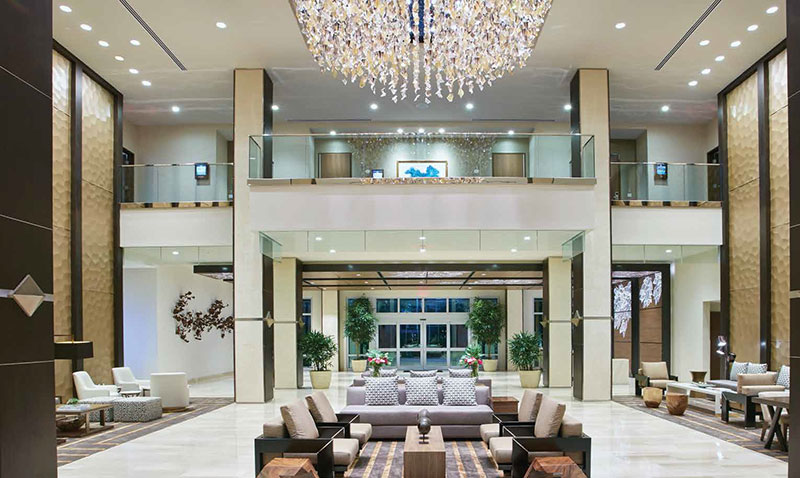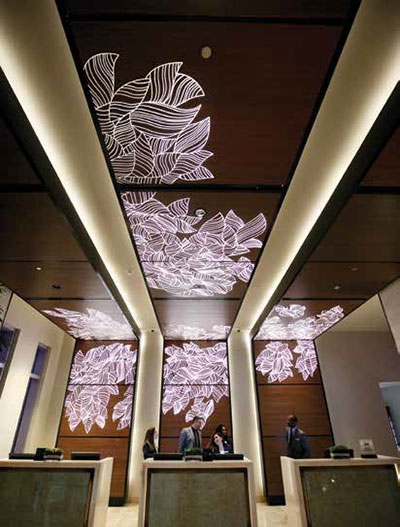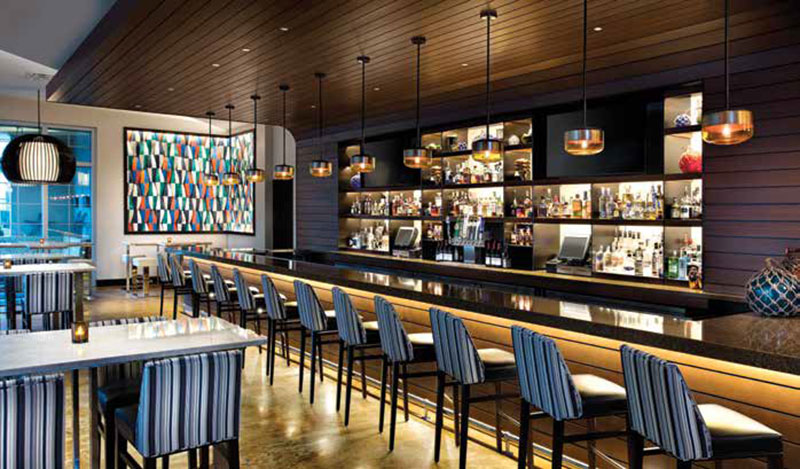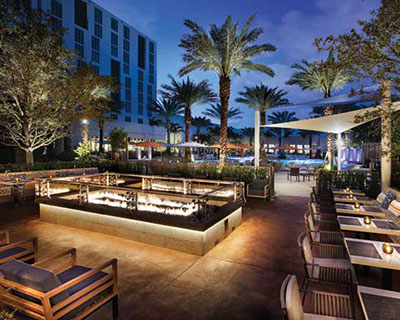From a backlit installation at reception to a dramatic poolside oasis, the Hilton in West Palm Beach, FL, will have you seeing stars
By Leonora Desar
In an era where luxury hotels dot the skyline and everyone is striving for that five-star rating, how do you differentiate yourself as a resort? And how do you create a sense of grandeur without intimidating people, or making the environment seem cold?

For Hilary Wainer, principal of Lux et Veritas Design in Atlanta and lighting designer for the Hilton in West Palm Beach, FL, the key was to provide vignettes and scenes, to have the lighting guide you from one moment to the next. “We always want to create a visual hierarchy,” Wainer says. “We want to draw your eye to the important places—when you walk into a hotel it’s usually your first time experiencing the place. You don’t want to walk in and be like, ‘Now what do I do?’”
First, find yourself walking to the reception area, drawn there by backlit wood. The backlit element wraps around the reception desk across the entry and back down the concierge station, and includes 458 sq ft of varying sized edge-lit LED panels (Rosco) and 44 remote power supplies. “We want you to walk in and go, ‘Wow, that’s really cool,’” Wainer says. “It’s providing visual interest, but at the same time it’s providing a bit of wayfinding.”
The effect is elegant, polished, though the process was far from effortless. “[The element] has sprinklers in it, it has HVAC in it, it has a ton of stuff,” Wainer says. “It was probably 100 hours of coordination to get it to look as simple as it does.”

THE CHANDELIER
A custom chandelier (iWorks) envisioned by the interior designer, Looney and Associates in Chicago, guides you from the 14-ft high entry to a grand, 28-ft high space in the lobby. The chandelier is an art piece, composed of hundreds of textured acrylic elements in golds and yellows and milky whites. “When you have a double-height space you either want to make a big statement or psychologically lower the height of the ceiling,” Wainer says. “In this case, [the interior designer] wanted to emphasize the grandness. The different colors of the textured acrylic are complementary to what is going on in the space, so it really helps to create a vision.”
To illuminate the acrylic of the chandelier, MR16 LED architectural downlights are recessed into the ceiling. The lights shine through the pieces, giving them presence, sparkle, dimension. “They allow you to see the colors more vividly,” Wainer says.
Wall washers (Gotham Lighting) highlight the textured walls, drawing your eye up to the chandelier. The fixtures feature a wall-washer optic, or a lens that provides an even wash across. “We didn’t want to use a fixture that was adjustable,” Wainer says. “Once the maintenance people got to it, you’d end up with one fixture providing a streak down the wall and another aimed up high and one down low.”
LED downlights (USAI Lighting) focus on the desks, bringing people’s faces into relief, as well as providing task light. “It’s important to have light on top of the desks,” Wainer says. “You’re reading your folios there, you are signing documents when you leave. At the same time, this is also your first impression, so you don’t want to walk up to a desk and not see people’s features.” Wainer used the USAI fixture family throughout the project, attracted by its varying diameters and optical packages as well as its small apertures. “You need some level of uniformity for a base layer of light so people can get from point A to B, but then you also need to bring focus to certain areas,” Wainer says. “You need different diameters or optical packages to do that.”
Floor and table lamps create individual seating areas, making guests feel as if they are in their own private nook. “It’s definitely adding that residential flair,” Wainer says. “This is supposed to be your home away from home.”

EAT, DRINK
In the bar, subtle lighting effects create an intimate atmosphere for dining and drinks. Shimmering glass accents are produced by uplighting translucent bottle risers and downlighting individual millwork shelves with concealed LED striplights. Decorative pendants create a psychological privacy barrier between guests while spotlights above the bar provide sparkle and task light for reading menus. Other decorative pendants
fill the space with softer tones. A playful nautically themed buoy sculpture has integrated LED tape light to create an additional focal point.
The Manor restaurant features an impressive array of decorative pendants using vintage LED lamping exuding a residential, cozy vibe. Commissioned murals bookend the space and are framed using LED tape light creating a stunning floating effect.

But while a grand lobby, food and drink are all well and good, let’s get real—in West Palm Beach, where sunny weather is king, it’s all about the pool.
The fire pit ring is illuminated with a concealed tape light (Acolyte), creating an art piece that patrons can enjoy while sipping margaritas. The light gives the impression that the fire pit is floating while also complementing the pit’s textured stone and providing pathway lighting. “We were able to kill three birds with one stone,” Wainer says. “We didn’t have to use poles or bollards or something less inviting, and the tape light’s integrated within the architecture.
“If you don’t conceal it, then you’re seeing a line of dots,” Wainer adds. “If it’s not a decorative piece, you really want to feel the effects of the light and not look at the source itself, especially because a lot of architectural lighting is not pretty per se. I really feel like it’s our job as architectural lighting designers to find ways to integrate as much as possible.”
Shade sails—or pieces of fabric that provide shade—are particularly useful in the sticky, South Florida humidity. To make them attractive as well as functional, the team lit them with extremely small LED uplights (SIMES) that throw out a wide pattern. “We wanted to use something that would be able to light the entire shade sail but be as inconspicuous as possible,” Wainer says. “If we used a normal floodlight it would throw a big hot streak of light as opposed to a nice soft glow.”
Rechargeable LED candles by the pool area also provide a glow that happens to be energy efficient—not to mention practical. “In most restaurant and bar scenes you’re going to want the flexibility to be able to move tables together,” Wainer says. “If you hardwire fixtures, you can’t move the tables.”
Stake-mounted uplights (BK Lighting) illuminate the pool area’s landscaping, providing the dramatic finishing touch. The designers used fixtures with a 20-25-deg narrow flood to accentuate palm trees, encompassing both the trees’ trunks and palm fronds. For the thicker specimen trees, the team used fixtures with a 40-deg beam or wider, ensuring the broadest spread of light. “It draws you in both visually and physically,” Wainer says. “You want to go and be like, ‘Wow, look at that pool,’ because the pool is one of the hotel’s proudest features.”
